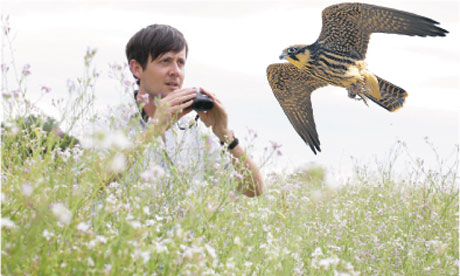
An alarmed cry rang out across the campsite. "A butterfly has got inside my tent," shouted Rob. "How do I get it out?" There, on the corner of his inflatable mattress, reclined camilla, the most graceful of woodland insects. Somehow, the white admiral, as it is better known, had glided through storm-proof polyester linings and gauze and zips to land in this shady dell.
A modern tent will protect you from pretty well any extreme weather event but, luckily, no camping technology can repel nature. Camping is a perfect kind of wildlife watching: by staying still, in one place, the wild things around you quickly take you for what you are – part of nature.
Within minutes of setting up camp in the folds of East Sussex by woods that were a purple carpet of bluebells in spring, a green woodpecker dipped across the field, a pair of buzzards soared on a thermal and a hobby watchfully flew overhead.
We began our commune with nature by taking a stroll across fields and through Wapsbourne Wood. Rabbits darted into bramble patches and the fields were full of jinking meadow brown butterflies. Grasshoppers rose like sparks, and along a tributary of the Ouse darted hefty black dragonflies.
At the brow of the hill, we were plunged into the crepuscular calm of the wood, emerging into the sunshine again in clearings where sweet chestnuts had been traditionally coppiced. These were full of the last of the foxgloves and the sickly, overpowering waft of the mysterious stinkhorn fungus.
Like all good nature walks, this one ended at the pub. When we returned to camp, great slants of evening sunshine illuminated a less welcome wild creature: swarms of small midges hung in the air. Our campfire sorted them out and a heron flapped lugubriously overhead before a heavy dew fell.
A night nature walk was a more confused, alcohol-addled affair and we were far too noisy and lacking in night vision to spot a deer or even a bat. You can zip yourself up as snug as you like in a tent at night but you can't block out the wildlife. As I drifted off to sleep, was that the bleating of a lamb or the hooting of an owl I could hear in one of the glorious old oaks that bordered Wapsbourne Wood? Sheep? Owl? I was asleep.
I hoped to wake to the grunt of a badger scouting for food around our tents, but it was a symphony of wood pigeons and the busy-body cark of a crow that caused me to stir at 5am. By July, the dawn chorus is virtually silent compared with the cacophony of spring but a chiffchaff still sounded in the distance. The valley was a crucible of grey blues and greens as a light morning rain pattered on the tent.
The most exciting morning encounter with our fellow mammals was when a colleague opened his eyes in the tipi. There, squatting in the debris of the previous evening's party, was a squirrel, munching on a sausage.
As the sun rose, the new day threw up the first hedge brown butterfly of the year and two purple hairstreaks tumbling in the crown of an oak. And the white admiral? After cupping my hands and freeing it from Rob's tent, it briskly flew into the trees. Despite all our time in the woods, we didn't see another on the trip. We cannot choose which wild creatures we camp with but they will find us – if they want to.
Wildlife spotted in East Sussex
Butterflies (13) meadow brown; hedge brown; speckled wood; essex skipper; small skipper; large skipper; comma; small tortoiseshell; large white; small white; green-veined white; purple hairstreak; white admiral
Birds (12) buzzard; hobby; wood pigeon; crow; chiffchaff; blackbird; chaffinch; grey heron; gull (unspecified); green woodpecker; magpie; owl (unspecified);
Mammals (2) squirrel; rabbit

